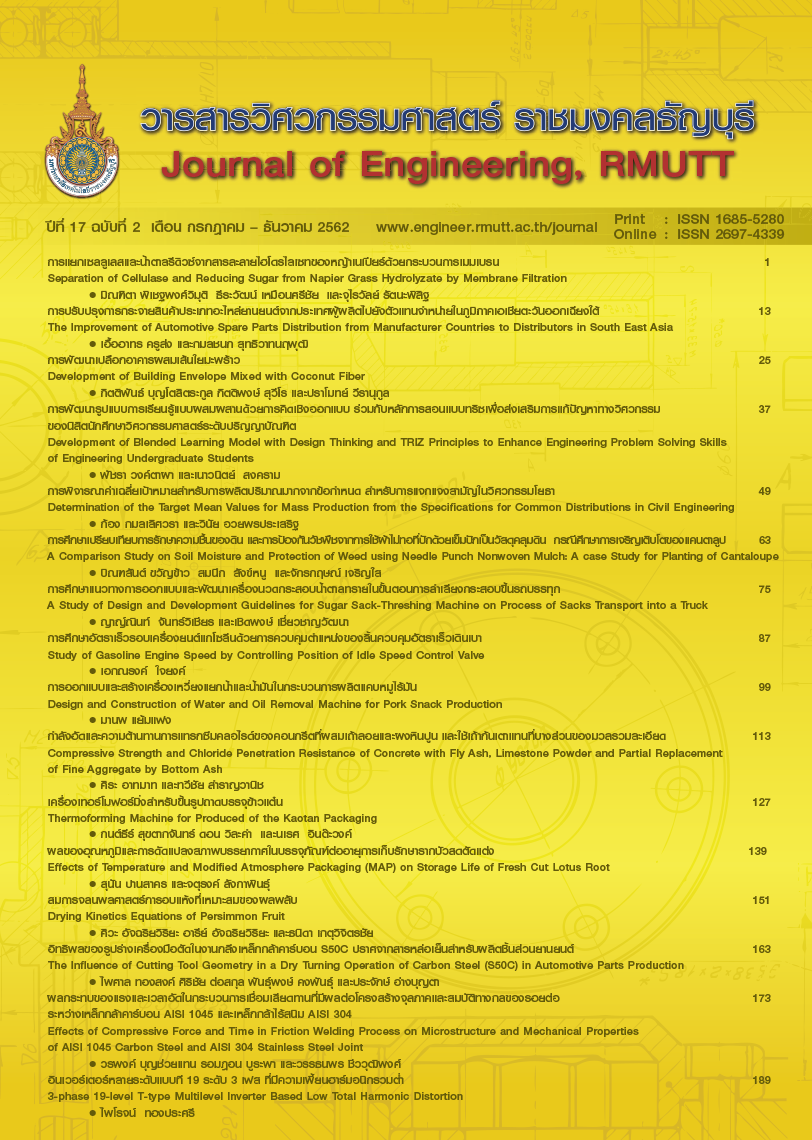The Influence of Cutting Tool Geometry in a Dry Turning Operation of Carbon Steel (S50C) in Automotive Parts Production
Main Article Content
Abstract
This research aims to investigate an influence of cutting tool geometry in a dry turning operation of the medium carbon steel (S50C) on a chip formation, cutting temperature, and surface roughness. Entering and rack angles were the main process parameters in this study ranged between -10o and 10o (-10o, -5o,0o,5o,10o) for both parameters, while other parameters, including cutting speed, feed rate and depth of cut, were fixed at 70 m/min, 0.5 mm/tooth/rev, and 0.5 mm, respectively. The cutting tool was a high speed steel (HSS) classification P with a cross-section of 14x14 mm. Based on the experimental results, it can be concluded that a tool wear, cutting temperature, and surface roughness can be reduced when the entering angle was increased. It can be found that a combination of 10° entering angle and 5° rack angle, -5° entering angle and 10° rack angle, and 10° entering angle and 0° rack angle resulted in the lowest tool wear, the lowest cutting temperature, and the lowest surface roughness in this study.
Article Details
The manuscript, information, content, picture and so forth which were published on Frontiers in engineering innovation research has been a copyright of this journal only. There is not allow anyone or any organize to duplicate all content or some document for unethical publication.
References
AB Sandvik Coromant. Modern metal cutting – a practical handbook: Tofters Tryckeri AB; 1994.
Cutting tool selection. [cited 2017 June]. Available from: http://tools-article.sumipol.com/insert-selection-technique-for-turning/ (in Thai)
Omar, O.E.E.K., El-Wardany, T, Ng, E, Elbestawi, M.A. An improved cutting force and surface topography prediction model in end milling. International journal of machine Tools & Manufacture. 2007;47: 1263-1275.
Moetakef Imani B. Identification of tool life and wear characteristics of HSS tools used in turning of Ck45. 2007.
DIN Standard. Terminology of chip removing; reference system and angles on the cutting part of the tool in DIN6581: DeutschesInstitutFurNor-mung E.V. (German National Standard). 1985.
Kudou K, Onob T, Okadac S. Crater wear characteristics of an Fe-diffused carbide cutting tool. Department of mechanical engineering, university of Kanagawa. 2003.
List G, Sutter G, Bouthiche A. Cutting temperature prediction in high speed machining by numerical modelling of chip formation and its dependence with crater wear. Laboratoire d'etude des microstructures et de mécanique des matériaux, université Paul Verlaine. 2012.
eligoprojects./ Different Types of Chips in Metal Cutting. [cited 2018 Feb 13]. Available from: https://
eligoprojects.com/different-types-of-chips-in-metal-cutting/
Boonrawd W, Ratanawilai T. Effect of turning parameters on surface rouhness of aluminum casting semi-solid. Research and development journal. 2012;23(4). (in Thai)
Zhu L, Shuang-Shuang P, Cheng-Long Y, Tien-Chien J, Xi C, Yi-Hsin Y. Cutting temperature, tool wear, and tool life in heat-pipe-assisted end-milling operations. Mechanical engineering department, An-Hui agricultural university. 2014.
Adeel H, Suhail, Ismail N, Wong S.V, Abdul Jalil N.A. Optimization of cutting parameters based on surface roughness and assistance of workpiece surface temperature in turning process. Department of mechanical and manufacturing engineering, faculty of engineering, Putra Malaysia university. 2010.

